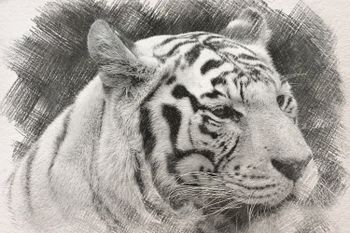Charcoal (art)
Charcoal is a drawing technique using various physical preparations of black, carbonized wood on paper. Like pastel, the material is soft, and provides more options than simple lines. Once the marks are on the surface, they can be smeared or feathered, to give shading, with fingertips and various tools. Different kinds of erasers can be used not only to remove errors, but to do "negative" drawing on the charcoal, selectively lightening or removing it, with some materials and technique allowing fine control.
Charcoal and graphite, while both black carbon for drawing, are quite different in texture and feel in the hand.
Charcoal art material
Most charcoal is in some type of stick form. Vine and willow charcoal are actually smoothed pieces of natural wood that then have been carbonized in an oven, and have slightly irregular shapes that correspond to the original material. Vine is more of a dark gray, while willow is distinctly black. These natural materials come in different hardnesses, but will normally have some fine airspaces in the stick, so it is very lightweight in the hand. It has a different "feel", however, than soft pastel. These are the most fragile forms and need a light touch.
Compressed charcoal sticks also come in various hardnesses, variously called soft to hard, or given designations from H (the hardest) to 8B (the softest). Compressed charcoal is mechanically stronger than vine or willow, and allows bolder strokes.
While the usual form of compressed charcoal is as a rectangular stick, much like a pastel, it also is available in the form of pencils. They may either be of the conventional wood-jacketed type, or "woodless" in the shape of a pencil and capable of being sharpened, but with no jacket. Charcoal pencils are good for beginners, as they do not break as easily as natural or stick forms. They are also useful for fine detail.
Charcoal is also available as a powder, of different shades of black, to be applied with a brush or other tool.
While technically not charcoals, "white" sticks and pencils, really pastels, can be used to lighten areas of a drawing, or provide a bright spot.
Paper and surface
Charcoal, like pastel, needs to be used on at least a somewhat textured rather than smooth surface; it tends to crumble on smooth paper and not spread well. While a basic white paper, of 40 pound or heavier lightly textured stock, is a good starting point, many variations in texture and weight are available, and will give different effects with different charcoals. Off-white and gray papers are often used, and interesting effects can come from using lightly colored papers.
Some artists may brush an abrasive material onto the surface of the paper, to encourage the charcoal to spread as dust.
Erasers
Several kinds are in different use. Kneadable erasers are of a soft, flexible, claylike material. As opposed to a conventional pencil eraser, the kneadable material lifts the charcoal from the paper, rather than rubbing it off. It will not remove all the charcoal with the first touch, so there is considerable control possible in lightening, "dabbing" at the charcoal. Slight stroking motions can give other effects, but it should not be applied with any significant pressure.
Vinyl erasers are harder and more like conventional erasers. The material is available both as rectangular slabs, and also as a thin cylinder held in a support much like that of a mechanical pencil. Using the cylinder, an edge, or a sharpened point, these firmer erasers can be used to remove very small amounts of charcoal, giving fine edge effects to lines. The materials come in white and black; since some eraser material may be left behind, black can be less obtrusive in a dark part of the drawing.
Somewhat softer than vinyl, but still firm and provided as rectangular blocks, is a material called artgum. Tan in color, it is rubbed like vinyl, but removes charcoal less aggressively. With all the eraser materials, however, it is the artist's touch that is the final determinant of effects.
It does take a certain reorientation to think of an eraser as a drawing tool, but such use is important in charcoal technique. Essentially, the artist is using the eraser to draw lighter areas on charcoal.
Tools
Various materials and tools can be used to smear the charcoal in a controlled way. Fingertips can work quite well, and charcoal washes off easily. It is wise to wash one's hands frequently when using charcoal, as dust tends to get on them and may get in unwanted places in the drawing. Some artists like to use a wrist rest to minimize inadvertent contact.
Also often for blending are stumps of tightly rolled paper, or softer tortillons of paper wound around a hollow center. A textured cloth, such as a chamois, is useful for blending over large areas; alternatives include textured paper towels, or even tissues. There are various specialized brushes, foam-tipped tools, and spatula-like metal tools. An ordinary cotton swab can be useful, as can be a soft wood or plastic burnisher.
A light, wide brush, or a air spray, is useful for clearing dust from the working drawing.
Mixed media
Compatible media, often transparent, may be used to underlay a pastel. These include watercolor and ink washes.
Fixative
Once the drawing is done, it is common to spray, or sometimes brush it, with a clear fixative that prevents the soft charcoal from damage. Fixatives are available that can give a glossy, matte, or textured finish. They can be used at intermediate stages, perhaps to layer charcoal more deeply than is possible by simple adhesion to the paper.
